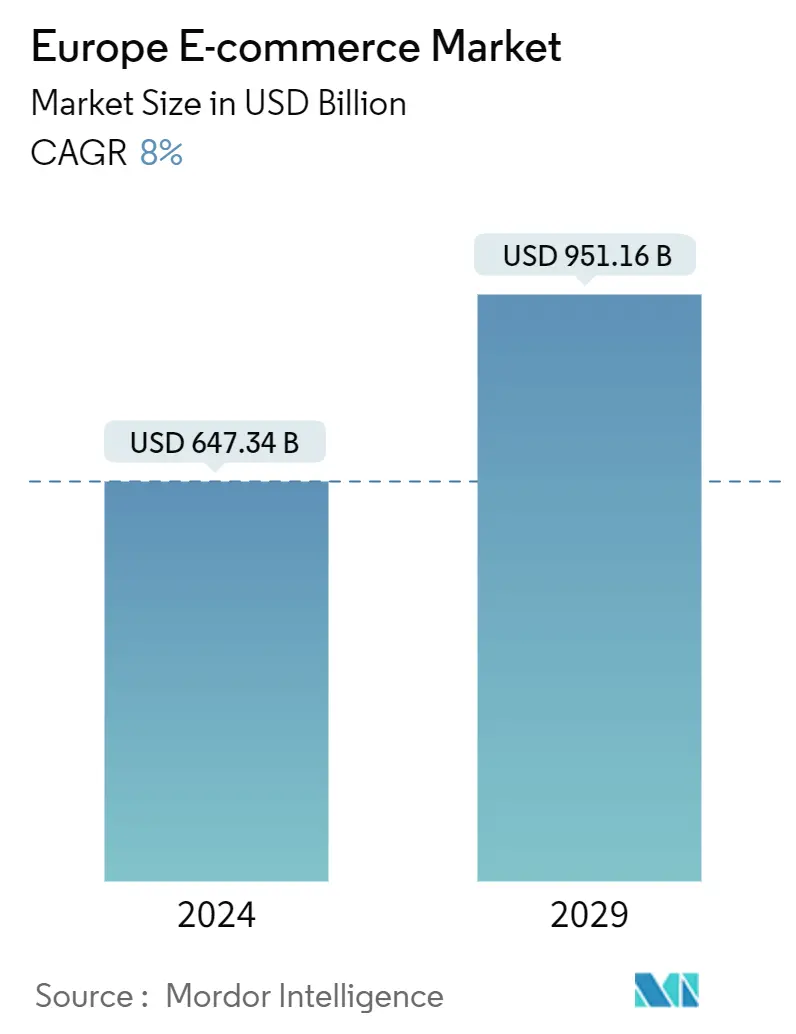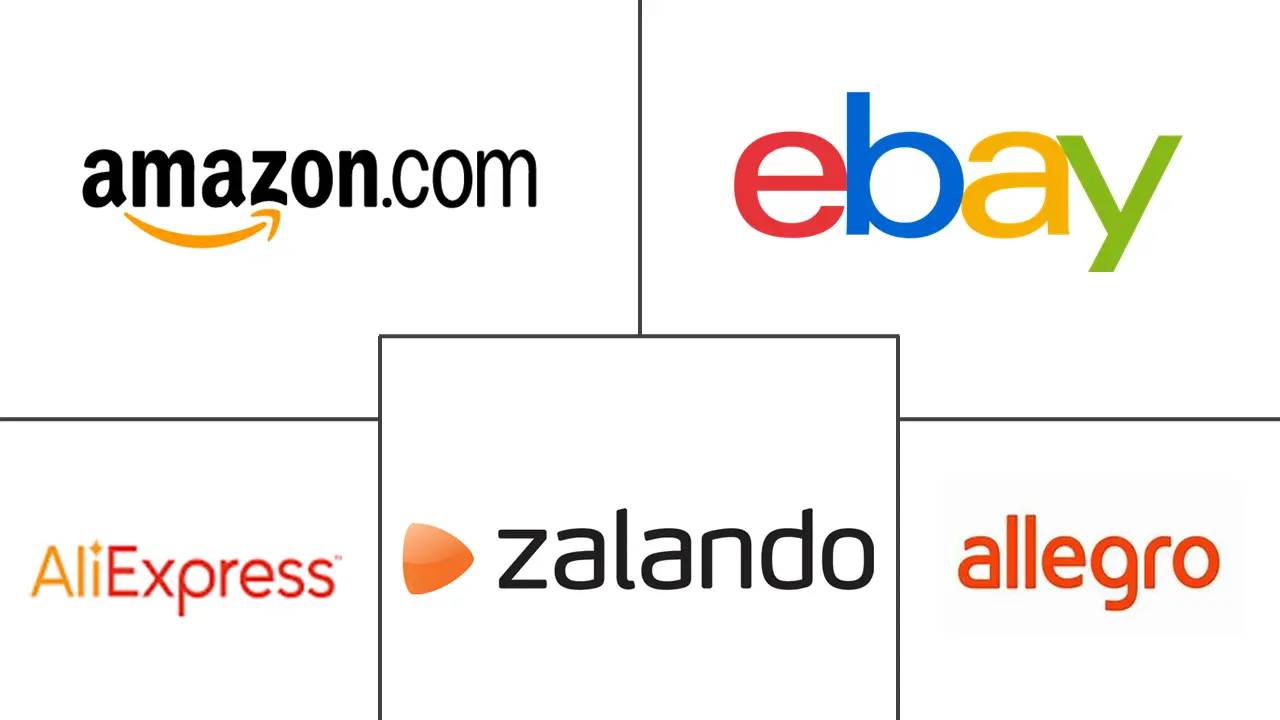Market Size of Europe E-commerce Industry

| Study Period | 2019 - 2029 |
| Base Year For Estimation | 2023 |
| Market Size (2024) | USD 647.34 Billion |
| Market Size (2029) | USD 951.16 Billion |
| CAGR (2024 - 2029) | 8.00 % |
| Market Concentration | Low |
Major Players
*Disclaimer: Major Players sorted in no particular order |
Need a report that reflects how COVID-19 has impacted this market and its growth?
Europe E-commerce Market Analysis
The Europe E-commerce Market size is estimated at USD 647.34 billion in 2024, and is expected to reach USD 951.16 billion by 2029, growing at a CAGR of 8% during the forecast period (2024-2029).
E-commerce is now redefining commercial activities worldwide, including in Europe. With the help of the internet, people can buy and sell any item, like books, electronics, apparel, software, furniture, etc., from anywhere.
- Previously, buying and selling goods required an active and physical interaction between the buyer and the seller. However, currently, brick-and-mortar commerce is quickly being replaced by eCommerce. Most brick-and-mortar stores are transforming into eCommerce stores, thus requiring establishing an online presence and moving core business operations online.
- Furthermore, European e-commerce experienced significant growth in B2C turnover in recent years, despite some countries reporting lower e-commerce sales due to the lessening of COVID-19 pandemic measures. Also, Eastern Europe has experienced higher growth rates in B2C e-commerce sales than many Western European countries. However, Western Europe still holds the largest share of total turnover at 63% compared to Eastern Europe's 2% (as of 2021), per the European E-commerce report 2022.
- However, the EU is home to diverse and intricate digital markets. Although the share of the population accessing the internet and shopping online continues to grow, SMEs selling online continue to lag in their use of digital tools.
- The COVID-19 outbreak significantly impacted European countries such as Spain, Italy, Germany, France, the United Kingdom, Turkey, and Switzerland. Despite the nationwide lockdown, online sales had shown a positive response. The European government closed most brick and mortar retail stores as a precautionary measure as part of a series of lockdown plans to contain the spread of COVID-19. As a result, there is a high demand for online shopping for essential and non-essential products such as groceries, clothing, and accessories.
Europe E-commerce Industry Segmentation
E-commerce is the purchasing and selling of products and services over the Internet. It is conducted over computers, mobiles, tablets, and other smart devices. There are primarily two e-commerce types: Business-to-Consumer (B2C) and Business-to-Business (B2B).
The European e-commerce market is segmented by b2c e-commerce (beauty and personal care, consumer electronics, fashion and apparel, food and beverage, furniture and home), b2b e-commerce, and country(United Kingdom, Germany, France, Spain, Italy, Nordics, Rest of Europe [Eastern Europe, Benelux]). The market sizes and forecasts are provided in terms of value (USD) for all the above segments.
| By B2C eCommerce | ||||||||
| Market size (GMV) for the period of 2018-2028 | ||||||||
|
| By B2B eCommerce | |
| Market size for the period of 2018-2028 |
| By Country | |
| United Kingdom | |
| Germany | |
| France | |
| Spain | |
| Italy | |
| Nordics | |
| Rest of Europe (Eastern Europe, Benelux, etc.) |
Europe E-commerce Market Size Summary
The European E-commerce market is witnessing significant growth and is expected to continue expanding in the coming years. This growth is driven by the increasing number of e-shoppers, the rise of online marketplaces, and the shift from brick-and-mortar stores to e-commerce platforms. The market is highly competitive with numerous prominent players employing strategies such as product launches, R&D investments, acquisitions, and partnerships to maintain their market position. Despite some countries reporting lower e-commerce sales due to the easing of COVID-19 measures, the B2C turnover in the European e-commerce sector has seen substantial growth. The beauty and personal care sector, in particular, has experienced rapid growth with the rise of e-commerce. Consumers are also showing an increasing preference for natural personal care products, driving demand in the market. The European E-commerce market also saw a positive response in online sales during nationwide lockdowns, driven by high demand for both essential and non-essential products.
Explore MoreEurope E-commerce Market Size - Table of Contents
-
1. MARKET INSIGHTS
-
1.1 Market Overview
-
1.2 Industry Attractiveness-Porter's Five Forces Analysis
-
1.2.1 Bargaining Power of Suppliers
-
1.2.2 Bargaining Power of Buyers/Consumers
-
1.2.3 Threat of New Entrants
-
1.2.4 Threat of Substitute Products
-
1.2.5 Intensity of Competitive Rivalry
-
-
1.3 Key market trends and share of e-commerce of total Retail sector
-
1.4 Impact of COVID-19 on the e-commerce sales
-
-
2. Market Segmentation
-
2.1 By B2C eCommerce
-
2.1.1 Market size (GMV) for the period of 2018-2028
-
2.1.2 Market Segmentation - by Application
-
2.1.2.1 Beauty & Personal Care
-
2.1.2.2 Consumer Electronics
-
2.1.2.3 Fashion & Apparel
-
2.1.2.4 Food & Beverage
-
2.1.2.5 Furniture & Home
-
2.1.2.6 Others (Toys, DIY, Media, etc.)
-
-
-
2.2 By B2B eCommerce
-
2.2.1 Market size for the period of 2018-2028
-
-
2.3 By Country
-
2.3.1 United Kingdom
-
2.3.2 Germany
-
2.3.3 France
-
2.3.4 Spain
-
2.3.5 Italy
-
2.3.6 Nordics
-
2.3.7 Rest of Europe (Eastern Europe, Benelux, etc.)
-
-
Europe E-commerce Market Size FAQs
How big is the Europe E-commerce Market?
The Europe E-commerce Market size is expected to reach USD 647.34 billion in 2024 and grow at a CAGR of 8% to reach USD 951.16 billion by 2029.
What is the current Europe E-commerce Market size?
In 2024, the Europe E-commerce Market size is expected to reach USD 647.34 billion.

